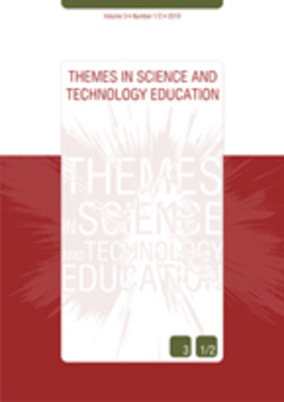Digital storytelling teaching robotics basics
Part of : Themes in science and technology education ; Vol.6, No.1, 2013, pages 39-49
Issue:
Pages:
39-49
Author:
Abstract:
Digital Storytelling (DST) is a powerful tool for teaching complex concepts. DSTs are typically used in the humanities but several papers have shown that they are also a wonderful tool for the sciences because they are more involving, contextualized and can easily lead to deeper understanding. In the classical use of DST the story is the content, while the digital medium is the way of telling it. Our approach is slightly different: the story is not the content but a glue for the main contents, while the digital medium remains the way to tell the story. We propose the use of DST as a means to teach surgeons the basics of robotic surgery, by using a story that should be involving for them, i.e. a surgical operation, within which we will illustrate specific concepts on robotics in surgery.
Subject:
Subject (LC):
Keywords:
Digital storytelling, robotics, training
Notes:
This research was supported by SAFROS project (www.safros.eu) funded by EU under grant agreement n. 248960. MS would like to thank Daniele Agostini for his invaluable support and comments.
References (1):
- Anderson, R. C. (1971). Encoding processes in the storage and retrieval of sentences. Journal of Experimental Psychology, 91(2), 338-340.Barrett, H. (2006). Researching and evaluating digital storytelling as a deep learning tool. In C. Crawford et al.(eds.), Proceedings of Society for Information Technology and Teacher Education International Conference 2006 (pp. 647-654). Chesapeake, VA: AACE.Beni, R.D., & Cornoldi, C. (1985). Effects of the mnemotechnique of loci in the memorization of concrete words. Acta Psychologica, 60(1), 11-24.Bizzocchi, J., & Schell, R. (2009). Rich-narrative case study for online PBL in medical education. Academic Medicine? Journal of the Association of American Medical Colleges, 84(10), 1412-1418. Borkan, J., Miller, W., & Reis, S. (1992). Medicine as storytelling. Family Practice, 9, 127-129.Bull, G., & Kajder, S. (2004). Digital storytelling in the language arts classroom. Learning & Leading with Technology, 32(4), 46-49.Center for Digital Storytelling (2012). Retrieved 3 February, 2012 from http://www.storycenter.org/index1.html.Cianciolo, A.T., Prevou, M., Cianciolo, D., & Morris, R. (2007). Using digital storytelling to stimulate discussion in Army professional forums. Proceedings of the Interservice/Industry Training, Simulation & Education Conference, I/ITSEC 2007 (pp. 1-12). Alexandria VA: National Defense Industrial Association.D’Alessandro, D.M., Lewis, T.E., & D’Alessandro, M.P. (2004). A pediatric digital storytelling system for third year medical students: the virtual pediatric patients. BMC Medical Education, 4-10.Hensel, W., & Rasco, T. (1992). Storytelling as a method for teaching values and attitudes. Academic medicine?: Journal of the Association of American Medical Colleges, 67, 500-504.Hoffman, B. (1997). Integrating technology into school. Education Digest, 62(5), 51-55.Piaget, J., Gruber, H.E., & Vonèche, J.J. (1995). The essential Piaget. Northvale NJ: J. Aronson.Mayers, K. (1995). Storytelling, a method to facilitate rapport with residents and share knowledge among long-term staff. Journal of Continuing Education in Nursing, 26, 280-282.Mergendollar J. (1997), Technology and learning: The research. Education Digest, 62(8), 12-15.Ohler, J. (2006). The world of digital storytelling. Educational Leadership, 63(4), 44-47.Papadimitriou, C. H. (2003). MythematiCS: in praise of storytelling in the teaching of computer science and math. SIGCSE Bulletin, 35(4), 7-9.Rabinowitz, S., Maoz, B., Weingarten, & M., Kasan, R. (1994). Listening to patient’s stories. Canadian Family Physician, 40, 2098-2102.Rao, K. (2006). Storytelling and puzzles in a software engineering course. Design, 418-422.Richards, T. (1998). Infusing technology and literacy into the undergraduate teacher education curriculum through the use of electronic portfolios. T.H.E. Journal, 25(9), 46-50.Robin, B. (2006). The educational uses of digital storytelling. Technology and Teacher Education, 1, 709-716.Sadik, A. (2008). Digital storytelling: a meaningful technology-integrated approach for engaged student learning.Educational Technology Research and Development, 56(4), 487-506.Schiro, M. (2004). Oral storytelling and teaching mathematics. Thousand Oaks, CS: Sage Publications.Spivey, N. (1997). The constructivist metaphor: Reading, writing, and the making of meaning. NY: Academic Press.Terry, L.M. (2012). Service user involvement in nurse education: A report on using online discussions with a service user to augment his digital story. Nurse Education Today, 32(2), 161-166.Visser, W. (1996). Use of episodic knowledge and information in design problem solving. Design Studies, 2, 171-187.




